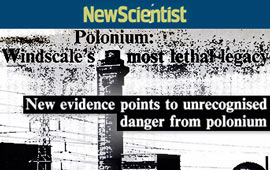As a side note:
Every time you are smoking a cigarette, you are inhaling polonium. Big Tobacco knows this and could easily remove the polonium, BUT that would greatly reduce the nicotine hit smokers are getting from smoking a cigarette, thereby smoking would be much less addictive and that would result in less profit (and cancer).
Journal of Environmental Radioactivity, W. Yang and L. Guo, NASA Stennis Space Center and Univ. of Southern Mississippi Dept. of Marine Science, 2012 (emphasis added): Depositional fluxes and residence time of atmospheric radioiodine (131I) from the Fukushima accident
- The Fukushima Dai-ichi nuclear power plant explosions… emitted vast quantities of radioactive materials into the environment… radioiodine (131I)… 134Cs and 137Cs are of special concern to people because they could trigger dangerous health effects
- However, data on time series depositional fluxes are still lacking, preventing… prediction of the scope of dispersion especially in North America
- Following the Fukushima accident, a high level of 131I was first detected on March 23 in a dry deposition sample at [NASA’s space center]
- After this initial fallout, the 131I depositional flux increased up to ten- to twenty-fold during the following two weeks, varying from 218 mBq/m^2/day to 463 Bq/m^2/day
- Concurrent high rainfall and high 131I fluxes were observed at the SSC site… from 97 to 337 mBq/L with an average of 217 mBq/L
- In addition to precipitation samples, 131I was also detectable in surface waters from the Pearl River in Mississippi, with an activity of 6.7 mBq/L
- Interestingly, the 210Po/210Pb ratios of the fallout samples during the peak 131I fallout period were anomalously high… Before and after the Fukushima accident, the environmental 210Po/210Pb ratio in precipitation samples varied from 0.02 to 0.09 with an average of 0.06 at the SSC in southern Mississippi… However, the 210Po/210Pb ratio during the Fukushima fallout was up to 1.5 on March 23…
- To date, excess 210Po in the atmosphere was only reported for high temperature activities such as volcanic eruptions or degassing… Therefore, the anomalously high 210Po/210Pb ratios observed in the southern US were mostly derived from the Fukushima Dai-ichi nuclear plant explosions which could have resulted in the fractionation of environmental 210Po and 210Pb and thus the preferential release of volatile 210Po into the atmosphere. Indeed, the anomalous 210Po/210Pb ratios were accompanied by the peak fallout of 131I… indicating that the Fukushima nuclear plant explosions mainly contributed to the anomaly in the 210Po/210Pb ratio…
- it seemed that regions reachable by 131I transport within two weeks from Fukushima would receive much more fallout…
New Scientist, Mar 1983: 25 years since the nuclear accident at Windscale… Attention has centred [on] radioactive iodine… the National Radiological Protection Board (NRPB) said the iodine-131 may have killed 13… However, the damage to health may have been much more severe… Indeed, it could represent the worst environmental disaster that Western Europe has known this century… re-examination of the data… reveals that one crucial isotope released in the fire has been ignored… there was one isotope released in the accident that is highly mobile [with] a high take-up by the human body… this was only revealed this week by the NRPB after New Scientist’s inquiries… It is polonium… polonium could give… a total dose to the UK of 5 million man-rems… the death figures may have to be revised significantly upwards… The figures suggest that some 1200 excess cases of leukaemia may have been caused in Britain by the Windscale accident. Since leukaemia deaths account for some 15 per cent of cancers attributable to nuclear accidents, the total toll of cancer deaths suggested is 8000… Clearly further investigations into the whole of the Windscale accident must be urgently pursued. The British are in effect now the nuclear laboratory of the world.
Woods Hole’s Ken Buesseler and others have cited polonium-210 levels in seafood tested for Fukushima radionuclides, for example: “Doses from eating fish are very low off US, and in fact 500 times greater from a natural radionucli
